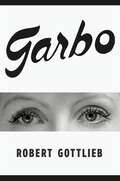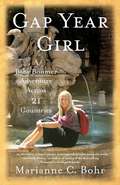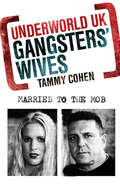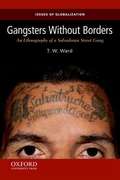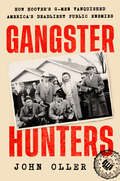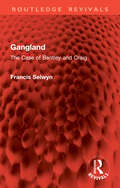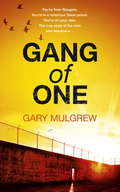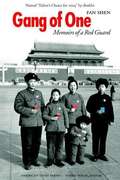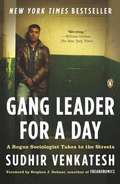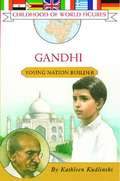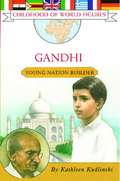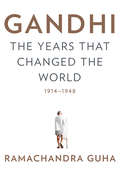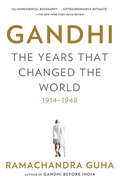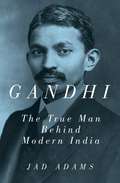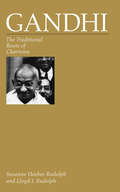- Table View
- List View
Garbo
by Robert GottliebA New York Times Book Review Editors' Choice | One of Literary Hub's most anticipated books of 2021Award-winning master critic Robert Gottlieb takes a singular and multifaceted look at the life of silver screen legend Greta Garbo, and the culture that worshiped her.“Wherever you look in the period between 1925 and 1941,” Robert Gottlieb writes in Garbo, “Greta Garbo is in people’s minds, hearts, and dreams.” Strikingly glamorous and famously inscrutable, she managed, in sixteen short years, to infiltrate the world’s subconscious; the end of her film career, when she was thirty-six, only made her more irresistible. Garbo appeared in just twenty-four Hollywood movies, yet her impact on the world—and that indescribable, transcendent presence she possessed—was rivaled only by Marilyn Monroe’s. She was looked on as a unique phenomenon, a sphinx, a myth, the most beautiful woman in the world, but in reality she was a Swedish peasant girl, uneducated, naïve, and always on her guard. When she arrived in Hollywood, aged nineteen, she spoke barely a word of English and was completely unprepared for the ferocious publicity that quickly adhered to her as, almost overnight, she became the world’s most famous actress.In Garbo, the acclaimed critic and editor Robert Gottlieb offers a vivid and thorough retelling of her life, beginning in the slums of Stockholm and proceeding through her years of struggling to elude the attention of the world—her desperate, futile striving to be “left alone.” He takes us through the films themselves, from M-G-M’s early presentation of her as a “vamp”—her overwhelming beauty drawing men to their doom, a formula she loathed—to the artistic heights of Camille and Ninotchka (“Garbo Laughs!”), by way of Anna Christie (“Garbo Talks!”), Mata Hari, and Grand Hotel. He examines her passive withdrawal from the movies, and the endless attempts to draw her back. And he sketches the life she led as a very wealthy woman in New York—“a hermit about town”—and the life she led in Europe among the Rothschilds and men like Onassis and Churchill. Her relationships with her famous co-star John Gilbert, with Cecil Beaton, with Leopold Stokowski, with Erich Maria Remarque, with George Schlee—were they consummated? Was she bisexual? Was she sexual at all? The whole world wanted to know—and still wants to know.In addition to offering his rich account of her life, Gottlieb, in what he calls “A Garbo Reader,” brings together a remarkable assembly of glimpses of Garbo from other people’s memoirs and interviews, ranging from Ingmar Bergman and Tallulah Bankhead to Roland Barthes; from literature (she turns up everywhere—in Hemingway’s For Whom the Bell Tolls, in Evelyn Waugh, Graham Greene, and the letters of Marianne Moore and Alice B. Toklas); from countless songs and cartoons and articles of merchandise. Most extraordinary of all are the pictures—250 or so ravishing movie stills, formal portraits, and revealing snapshots—all reproduced here in superb duotone. She had no personal vanity, no interest in clothes and make-up, yet the story of Garbo is essentially the story of a face and the camera. Forty years after her career ended, she was still being tormented by unrelenting paparazzi wherever she went.Includes Black-and-White Photographs
Gap Year Girl: A Baby Boomer Adventure Across 21 Countries
by Marianne C. BohrIn the 1960s and &’70s, thousands of baby boomers strapped packs to their backs and flocked to Europe, wandering the continent on missions of self-discovery. Many of these boomers still dream of &“going back&”—of once again cutting themselves free and revisiting the places they encountered in their youth, recapturing what was, and creating fresh memories along the way. Marianne Bohr and her husband, Joe, did just that. In Gap Year Girl, Bohr describes what it&’s like to kiss your job good-bye, sell your worldly possessions, pack your bags, and take off on a quest for adventure. Page by page, she engagingly recounts the experiences, epiphanies, highs, lows, struggles, surprises, and lessons learned as she and Joe journey as independent travelers on a budget—through medieval villages and bustling European cities, unimaginable culinary pleasures, and the entertaining (and sometimes infuriating) characters encountered along the way. Touching on universal themes of escape, adventure, freedom, discovery, and life reimagined, Gap Year Girl is an exciting account of a couple&’s experiences on an unconventional, past the-blush-of-youth journey.
Gangsters' Wives
by Tammy CohenBehind every good man is a good woman. But what lies behind every bad man? Gangsters' Wives tells the side of the story you didn't know--what it's like to live with Britain's most lawless men, from the women who married them.Devoted mum-of-three Judy Marks was imprisoned alongside her husband, notorious drug smuggler Howard Marks; while Flanagan, the first ever Page Three girl, found herself splashed across the papers as the fiancee of legendary East End villain Reggie Kray. Jenny Pinto, wife of gangster Dave Courtney, has given the police keys to their house to stop them breaking down the front door.In ten funny, moving, searingly honest first-person accounts, Gangsters' Wives tells you all you ever wanted to know about the lives and loves of the women who are, quite literally, married to the mob.
Gangsters Without Borders: An Ethnography of a Salvadoran Street Gang (Issues of Globalization: Case Studies in Contemporary Anthropology)
by T. W. Ward<p>Based on author T.W. Ward's eight and a half years in Los Angeles conducting participant observation with MS-13, Gangsters Without Borders: An Ethnography of a Salvadoran Street Gang takes an inside look at gang life in the United States and in a global context. <p>Taking us through their journey from their homeland in El Salvador to the mean streets of Los Angeles, Gangsters Without Borders offers a perspective from the point of view of the hard-core members who live this hard, fast, and dangerous life. <p>A powerful and engaging overview of gang dynamics, Gangsters Without Borders contextualizes the sources and severity of the marginalization felt by Salvadoran immigrants and debunks myths about street gangs in the United States. This account of gangster's lives before, during, and after their involvement with the gang, delivers an intimate and analytical portrait unlike any other.</p>
Gangster Hunters: How Hoover's G-men Vanquished America's Deadliest Public Enemies
by John OllerThe enthralling, can't-put-down account of the birth of the modern FBI.J. Edgar Hoover was the face of the FBI. But the federal agents in the field, relentlessly chasing the most notorious gangsters of the 1930s with their own lives on the line, truly transformed the Bureau. In 1932, the FBI lacked jurisdiction over murder cases, bank robberies, and kidnappings. Relegated to the sidelines, agents spent their days at their desks. But all of that changed during the War on Crime. Hunting down infamous public enemies in tense, frequently blood-soaked shootouts, the Bureau was thrust onto the front pages for the first time.Young agents, fresh out of law school and anticipating a quiet, white-collar job, faced off with murderous felons who were heavily armed, clad in bulletproof vests, and owned cars that outraced the best vehicles the Bureau had. But the federal men were fiercely devoted—to the Bureau, to each other, and to bringing America&’s most wanted criminals to justice.The G-men crisscrossed the United States in pursuit of John Dillinger, Bonnie and Clyde, Ma Barker's criminal family, Baby Face Nelson, and Pretty Boy Floyd. But the green FBI agents were always one step behind and a moment too late, the criminals evading elaborate stakeouts and dramatic ambushes. Facing mounting criticism, with bodies left in their wake, the agents had to learn to adapt. After all, more than their reputations were at stake. Through incredible primary source research, John Oller transports readers right to the most harrowing and consequential raids of the 1930s, with fast-paced action that shows the lengths both sides would go to win.
Gangs in Garden City: How Immigration, Segregation, and Youth Violence are Changing America's Suburbs
by Sarah GarlandFor the past five years, journalist Sarah Garland has followed the lives of current and former gang members living in Hempstead on the border of Garden City, Long Island. Affiliated with Mara Salvatrucha and 18th Street, their troubling personal stories expose the cruel realities of segregation, racial income gaps, and poverty that lie hidden behind suburban white picket fences. As Garland travels from Los Angeles to El Salvador and back to the East Coast, she reveals a disturbing cycle of poverty in which families, fleeing from troubled Central American cities, move into America’s suburban backyards, only to find the pattern of violence repeating itself. Brilliantly reported and sensitively told,Gangs in Garden Citydraws back the veil on a hidden, troubling world.
Gangland: The Case of Bentley and Craig (Routledge Revivals)
by Francis SelwynOn the evening of 2nd November 1952, a shot fired from a makeshift weapon on a warehouse roof in Croydon killed PC Sidney Miles. Next morning the newspaper headlines proclaimed a Chicago gun-battle in London, gangsters machine-gunning armed police over the rooftops.But the trial of Bentley and Craig affronted common sense and alienated a generation raised in the post-war suburbia of cinemas, coffee bars and drab streets. How could Derek Bentley, nineteen and with learning difficulties, be hanged for a murder committed a quarter of an hour after he was arrested? Lord Chief Justice Goddard and the Home Secretary, Sir David Maxwell Fyfe, found a way. The nation was split into those determined to teach young thugs a lesson and those dismayed by an act of judicial murder. The execution of Bentley, wrote Kenneth Allsop in Picture Post, caused an emotional upset in England comparable only to Dunkirk and the death of George VI.Originally published in 1988, Gangland evokes the high drama of those weeks in the autumn of 1952. The moral authoritarianism of the Churchill government was backed by Lord Goddard’s zeal for hanging and flogging, by women’s groups demanding tougher sentences and corporal punishment, by a popular press which portrayed society under threat from cosh-boys and teenage gunmen, flick knives and horror comics, violence on the cinema screen and the printed page.Against this the demonstrators packed Whitehall, chanting ‘Bentley must not die!’ Others pointed out that violent crime was falling rather than rising. Bentley went to his death and thereby perhaps did more to discredit capital punishment than anyone. The facts of the case, including hysteria over sex and violence in the media and the clamour over rising crime which helped to ensure his execution, have a relevance to all periods of history – not least our own.
Gang of One: One Man's Incredible Battle to Find his Missing Daughter
by Gary MulgrewGANG OF ONE is the remarkable true story of one man's journey from a Glasgow orphanage to a notorious gang-infested prison in Texas. Driven by his desire to return to his son in England and haunted by the increasingly frustrating search for his missing daughter, Gary Mulgrew attempts the impossible task of surviving the prison's gang culture. Told with wit and humanity, GANG OF ONE shows a man constantly confronted by the moral and physical challenges of prison life, where everyone is encouraged to turn their back and 'see nuthin''. Gary's choice - to walk away and let a man die, or intervene and lose the chance to get home - makes GANG OF ONE a book as unforgettable as it is enthralling.
Gang of One: One Man's Incredible Battle to Find his Missing Daughter
by Gary MulgrewGANG OF ONE is the remarkable true story of one man's journey from a Glasgow orphanage to a notorious gang-infested prison in Texas. Driven by his desire to return to his son in England and haunted by the increasingly frustrating search for his missing daughter, Gary Mulgrew attempts the impossible task of surviving the prison's gang culture. Told with wit and humanity, GANG OF ONE shows a man constantly confronted by the moral and physical challenges of prison life, where everyone is encouraged to turn their back and 'see nuthin''. Gary's choice - to walk away and let a man die, or intervene and lose the chance to get home - makes GANG OF ONE a book as unforgettable as it is enthralling.
Gang of One: Memoirs of a Red Guard
by Fan ShenIn 1966 twelve-year-old Fan Shen, a newly minted Red Guard, plunged happily into China's Cultural Revolution. Disillusion soon followed, then turned to disgust and fear when Shen discovered that his compatriots had tortured and murdered a doctor whose house he'd helped raid and whose beautiful daughter he secretly adored. A story of coming of age in the midst of monumental historical upheaval, Shen's Gang of One is more than a memoir of one young man's harrowing experience during a time of terror. It is also, in spite of circumstances of remarkable grimness and injustice, an unlikely picaresque tale of adventure full of courage, cunning, wit, tenacity, resourcefulness, and sheer luck--the story of how Shen managed to scheme his way through a hugely oppressive system and emerge triumphant. Gang of One recounts how Shen escaped, again and again, from his appointed fate, as when he somehow found himself a doctor at sixteen and even, miraculously, saved a few lives. In such volatile times, however, good luck could quickly turn to misfortune: a transfer to the East Wind Aircraft Factory got him out of the countryside and into another terrible trap, where many people were driven to suicide; his secret self-education took him from the factory to college, where friendship with an American teacher earned him the wrath of the secret police. Following a path strewn with perils and pitfalls, twists and surprises worthy of Dickens, Shen's story is ultimately an exuberant human comedy unlike any other.
Gang Leader for a Day
by Sudhir VenkateshA New York Times BestsellerForeword by Stephen J. Dubner, coauthor of FreakonomicsWhen first-year graduate student Sudhir Venkatesh walked into an abandoned building in one of Chicago's most notorious housing projects, he hoped to find a few people willing to take a multiple-choice survey on urban poverty--and impress his professors with his boldness. He never imagined that as a result of this assignment he would befriend a gang leader named JT and spend the better part of a decade embedded inside the projects under JT's protection. From a privileged position of unprecedented access, Venkatesh observed JT and the rest of his gang as they operated their crack-selling business, made peace with their neighbors, evaded the law, and rose up or fell within the ranks of the gang's complex hierarchical structure. Examining the morally ambiguous, highly intricate, and often corrupt struggle to survive in an urban war zone, Gang Leader for a Day also tells the story of the complicated friendship that develops between Venkatesh and JT--two young and ambitious men a universe apart."Riveting." --The New York Times"Compelling... dramatic... Venkatesh gives readers a window into a way of life that few Americans understand." --Newsweek"An eye-opening account into an underserved city within the city." --Chicago Tribune"The achievement of Gang Leader for a Day is to give the dry statistics a raw, beating heart." --The Boston Globe"A rich portrait of the urban poor, drawn not from statistics but from viivd tales of their lives and his, and how they intertwined." --The Economist"A sensative, sympathetic, unpatronizing portrayal of lives that are ususally ignored or lumped into ill-defined stereotype." --Finanical TimesSudhir Venkatesh's latest book Floating City: A Rogue Sociologist Lost and Found in New York's Underground Economy--a memoir of sociological investigation revealing the true face of America's most diverse city--was published in September 2013 by The Penguin Press
Gandhinvishyee Khand 2 - Gandhivichar aani Samakaleen Vicharvishwa: गांधींविषयी खंड २ - गांधीविचार आणि समकालीन विचारविश्व
by Ashok Chausalkarगांधी विचार आणि समकालीन विचारविश्व या पुस्तकात महात्मा गांधींच्या तत्त्वज्ञानाचा आणि त्यांच्या समकालीन विचारवंतांशी असलेल्या नातेसंबंधांचा विविध अंगांनी अभ्यास केलेला आहे. तीन खंडांमध्ये विभागलेले हे पुस्तक गांधींच्या तत्त्वज्ञानाचा तुलनात्मक आणि सखोल अभ्यास मांडते. पहिला खंड गांधींच्या व्यक्तिमत्त्वाचा, त्यांच्या कार्याचा आणि विचारांचा वेध घेतो, तर दुसऱ्या खंडात गांधींचा सॉक्रेटिस, टॉलस्टॉय, मार्क्स, गोखले, टिळक यांसारख्या विचारवंतांशी असलेला अनुबंध अभ्यासला आहे. तिसऱ्या खंडात गांधींच्या तत्त्वज्ञानाचा संदर्भ सामाजिक परिवर्तन, शाश्वत विकास, पर्यावरण, शिक्षण यांसारख्या आधुनिक विषयांशी जोडला आहे. संपादक अशोक चौसाळकर यांच्या मार्गदर्शनाखाली या ग्रंथाने गांधी विचारांची व्यापक संदर्भ चौकट उभी केली आहे. पुस्तकातून गांधींच्या सत्य, अहिंसा आणि समाजवादाच्या विचारांवर विशेष भर देण्यात आला आहे, ज्यामुळे आजच्या काळातील सामाजिक, राजकीय आणि आर्थिक समस्यांवर एकात्मिक दृष्टिकोन देण्याचा प्रयत्न झाला आहे.
Gandhinvishyee Khand 1 - Gandhi Jeevan aani Karya: गांधींविषयी खंड १ - गांधी जीवन आणि कार्य
by Kishor Bedkihal"गांधींविषयी" खंड १, २ आणि ३ या त्रिखंडात्मक ग्रंथमालेत महात्मा गांधींच्या जीवन, कार्य आणि तत्त्वज्ञानाचा व्यापक वेध घेतला आहे. पहिल्या खंडात गांधींच्या जीवनप्रवासाचे, त्यांच्या सत्याग्रह, अहिंसा, आणि समता यांसारख्या मूलभूत तत्त्वज्ञानाचे सविस्तर विवेचन आहे. गांधींनी समाजातील शेवटच्या व्यक्तीपर्यंत न्याय पोहोचवण्यासाठी केलेल्या प्रयत्नांचा व त्यांच्या कार्याच्या परिणामांचा अभ्यासही यात आहे. दुसऱ्या खंडात गांधींच्या तत्त्वज्ञानाचा तुलनात्मक अभ्यास सॉक्रेटिस, टॉलस्टॉय, टागोर, आणि गोखल्यांसारख्या विविध व्यक्तींशी केला आहे. त्यांच्या वैचारिक वादविवादांतून गांधींच्या विचारधारेला आलेली प्रगल्भता स्पष्ट होते. तिसऱ्या खंडात गांधी विचारांची वर्तमानकाळातील उपयुक्तता, सामाजिक-आर्थिक बदलांच्या संदर्भात त्यांचे महत्त्व, आणि पर्यावरण, तंत्रज्ञान यांसारख्या विषयांवरील त्यांच्या दृष्टिकोनाची चर्चा आहे. या ग्रंथमालेत गांधींच्या विचारांचे बहुआयामी पैलू उलगडत असून, त्यांच्या विचारांमधून वर्तमानकाळातील आव्हानांवर उपाय शोधण्याचा प्रयत्न केला आहे. गांधींचे कार्य केवळ ऐतिहासिकदृष्ट्या महत्त्वाचे नाही, तर ते भविष्यातील मानवी समाजासाठीही दीपस्तंभ ठरू शकते, हे या ग्रंथातून अधोरेखित होते.
Gandhijiyin Irudhi 200 Naatkal: காந்திஜியின் இறுதி 200 நாட்கள்
by V. Ramamurthyஇந்நூலில் காந்திஜியின் கடைசி 200 நாட்கள் ஆவணப்படுத்தப்பட்டிருக்கின்றன. மேலும் அவர் தன்னுடைய கடைசி 200 நாட்களில் மக்களுக்காக எவ்வளவு பாடுபட்டார் என்பதை பற்றி வி. ராமமூர்த்தி மிகவும் அவர்கள் மிகுந்த பொறுப்புணர்வுடன் கூறியுள்ளார்.
Gandhijinu Jivan — Emnaj Shabdoma
by Krishna Kruplaniહું મારા ઘરની આસપાસ દીવાલ ચણી લેવા તથા મારી બારીઓ બંધ કરી દેવા નથી માગતો. મારા ઘરની આસપાસ સઘળા દેશોની સંસ્કૃતિના પવનની લહેરીઓ છૂટથી વાતી રહે એમ હું ઇચ્છું છું. પણ પવનની એવી કોઈ લહરી દ્વારા જમીનથી અધ્ધર થઈ જવાનો હું ઇનકાર કરું છું. સાહિત્યમાં રસ ધરાવતાં આપણાં તરુણ સ્ત્રીપુરુષો અંગ્રેજી ભાષા તેમ જ બીજી વિશ્વભાષાઓ પેટ ભરીને શીખે એમ હું ઇચ્છું છું. અને પછી તેઓ જગદીશચંદ્ર બોઝ, પ્રફુલ્લચંદ્ર રોય અને કવિવર રવીન્દ્રનાથ ટાગોરની પેઠે પોતાના અભ્યાસનો લાભ હિંદને તથા દુનિયાને આપે એવી તેમની પાસેથી અપેક્ષા રાખું. પરંતુ એક પણ હિંદવાસી પોતાની માતૃભાષાને ભૂલે, તેની અવગણના કરે કે તેનાથી શરમાય અથવા પોતાની માતૃભાષામાં પોતે વિચાર કરી શકતો નથી કે પોતાના વિચારો સારામાં સારી રીતે દર્શાવી શકતો નથી એમ તેને લાગે, એમ હું ઇચ્છતો નથી. મારો ધર્મ ચોકાપંથી નથી. — ગાંધીજી
Gandhijiki Sankshipt Aatmakatha: गांधीजीकी संक्षिप्त आत्मकथा
by Kashinath Trivediबापूकी 'आत्मकथा' एक बड़ा ग्रंथ है। इस पुस्तकमें उसका सार तैयार किया गया है। ऐसा करते समय बापूके लेखन-क्रम, भाषा इत्यादिको प्रायः मूलके जैसा ही रखा गया है। केवल विषयको संक्षिप्त करने और सिलसिला जोड़नेके लिए कहीं-कहीं नयी भाषाका प्रयोग किया गया है। अतः सहज रूपसे यह कहा जा सकता है कि इस संक्षिप्त आत्मकथा' का ९९.९९ से भी अधिक भाग मूलका अवतरण ही है। इस 'संक्षिप्त आत्मकथा' को नये ढंगसे विभक्त किया गया है और कुछ अध्यायोंको उन विषयों के अनुरूप नये नाम दिये गये हैं। अध्यायों की गिनती प्रत्येक खण्डकी अलग-अलग न करके समूची पुस्तककी एक ही रखी गई है। बापूकी 'आत्मकथा' एक ऐसा ग्रंथ है, जो बापूको समझने में बहुत सहायक होता है। इसका संक्षिप्त संस्करण तैयार करनेका यह प्रयास इस अभिलाषासे किया गया है कि यह विशिष्ट व्यक्तियोंको और खासकर नयी पीढ़ीको बापूका अभ्यास करनेके लिए प्रेरित करे।
Gandhiji (Gujarati)
by Jugatram Daveગૂજરાત વિદ્યાપીઠ તરફથી દર વરસે ગાંધીજયંતીને દિવસે ‘ગાંધીજીવન-ઝાંખી‘ની પરીક્ષા લેવાય છે. પાંચથી સાત ધોરણના વિદ્યાર્થીઓ માટેની આ પરીક્ષામાં કુદસિયા જૈદીનું ‘ગાંધીબાપુ‘ પુસ્તક શરૂથી પાઠ્યપુસ્તક તરીકે ચાલે છે. ચાલુ વરસથી આ પુસ્તક ઉપરાંત ગાંધીજીના જીવનના પ્રસંગો આલેખતું સ્વ. શ્રી જુગતરામ દવેનું ‘ગાંધીજી‘ પુસ્તક પણ પાઠ્યપુસ્તક તરીકે ઉમેરવાનું નક્કી થયું છે. એ પુસ્તકની પહેલી આવૃત્તિ 1929માં પ્રસિદ્ધ થયેલી. આજ સુધીમાં તેની લગભગ લાખ જેટલી નકલો વેચાઈ છે. આ પુસ્તક એ જ પુસ્તકની પરીક્ષા માટેની રાહત દરની ખાસ આવૃત્તિ છે. પરીક્ષામાં બેસનાર વિદ્યાર્થીઓ ગાંધીજીના જીવન અને કાર્યને વ્યક્ત કરતાં કાવ્યોનો મુખપાઠ કરે તે જરૂરી લાગતાં આ આવૃત્તિમાં તેવાં પાંચ કાવ્યો પુસ્તકને અંતે આપ્યાં છે.
Gandhi: गांधी: कार्य व विचारप्रणाली
by Prof. Bhaskar Ramchandra Bapatगांधी आणि माओ या आधुनिक काळातील दोन अलौकिक क्रांतिकारक व्यक्ती होत. ‘पॉवर ग्रोज आउट ऑफ द बॅरल ऑफ ए गन’ असे म्हणणाऱ्या माओचे गांधींशी काय साम्य असे प्रथमतः वाटते. वरील वचनामध्ये माओ शासनसत्तेविषयी विलक्षण जागरूकता दाखवितो; समाजिक व्यवहारात सत्ता कोणाच्या हाती आहे हा मोक्याचा प्रश्न असतो हे स्पष्ट करतो. गांधी अराज्यवादी म्हणून ओळखले जातात.
Gandhi: Young Nation Builder (Childhood of Famous Americans Series)
by Kathleen V. KudlinskiThis book narrates the fascinating early years and eventual accomplishments of the inspiring leader, Mahatma Gandhi, who is known as the Father of the Nation of India.
Gandhi: Young Nation Builder
by Kathleen KudlinskiA childhood biography of the great political and social leader.Mohandas K. Gandhi (1869-1948) studied law in England, then spent 20 years defending the rights of immigrants in South Africa. In 1914 he returned to India and became the leader of the Indian National Congress. Gandhi urged non-violence and civil disobedience as a means to independence from Great Britain, with public acts of defiance that landed him in jail several times. In 1947 he participated in the postwar negotiations that led to Indian independence. He was shot to death by a Hindu fanatic in 1948. This childhood biography highlights the events that informed Gandhi's indomitable spirit.
Gandhi: The Years That Changed The World, 1914-1948
by Ramachandra GuhaAn epic and revelatory biography of one of the most abidingly influential--and controversial--men in modern history.Opening with Gandhi's triumphant return to India in 1915 after decades abroad, and ending with his tragic assassination in 1949, Gandhi: The Years that Changed the World is a remarkable, moving portrait that provides a crucial re-evaluation of India's iconic leader for a new generation. <p><p> Drawing on a wealth of newly uncovered materials unavailable to previous biographers, acclaimed historian and author Ramachandra Guha brings the past to life with extraordinary grace and clarity. Deploying his gifts as a storyteller and scholar, Guha presents Gandhi as both a fascinating human being--a man of fierce hope, eccentric personal beliefs, and sometimes dark and alarming contradictions--as well as a dynamic political force and global icon. <p> Sharp, insightful, balanced, and impeccably researched, this free-standing sequel to Guha's magisterial biography Gandhi Before India is an indispensable resource for a contemporary understanding of Gandhi's ever-evolving legacy.
Gandhi: The Years That Changed The World, 1914-1948
by Ramachandra GuhaThe second and concluding volume of the magisterial biography that began with the acclaimed, Gandhi Before India: the definitive portrait of the life and work of one of the most abidingly influential--and controversial--men in world history. <p><p> This volume opens with Mohandas Gandhi's arrival in Bombay in January 1915 and takes us through his epic struggles over the next three decades: to deliver India from British rule, to forge harmonious relations between India's Hindu and Muslim populations, to end the pernicious Hindu practice of untouchability, and to develop India's economic and moral self-reliance. We see how in each of these campaigns, Gandhi adapted methods of nonviolence--strikes, marches, fasts--that successfully challenged British authority, religious orthodoxy, social customs, and would influence non-violent, revolutionary movements throughout the world. <p> In reconstructing Gandhi's life and work, Ramachandra Guha has drawn on sixty different archival collections, the most significant among them, a previously unavailable collection of papers belonging to Gandhi himself. <p> Using this wealth of material, Guha creates a portrait of Gandhi and of those closest to him--family, friends, political and social leaders--that illuminates the complexity inside his thinking, his motives, his actions and their outcomes as he engaged with every important aspect of social and public life in the India of his time.
Gandhi: The True Man Behind Modern India
by Jad Adams"Provocative. Adams strips away Gandhi's saintly aura and explores the duality of India's most famous leader."--Financial Times Jad Adams traces the course of Gandhi's multi-faceted life and the development of his religious, political, and social thinking over seven tumultuous decades: from his comfortable upbringing in a princely state in Gujarat; his early civil rights campaigns; his leadership through civil disobedience in the 1920s and 1930s that made him a world icon; and finally to his assassination by a Hindu extremist in 1948, only months after the birth of an independent India. An elegant and masterly account of one of the seminal figures of twentieth-century history, Adams presents for the first time the true story behind the man whose life may truly be said to have changed the world.
Gandhi: The Traditional Roots of Charisma
by Susanne Hoeber Rudolph Lloyd I. RudolphThe Rudolphs' analysis reveals that Gandhi's charisma was deeply rooted in the aspects of Indian tradition that he interpreted for his time. They key to his political influence was his ability to realize in both his daily life and his public actions, cultural ideals that many Indians honored but could not enact themselves—ideals such as the traditional Hindu belief that a person's capacity for self-control enhances his capacity to control his environment. Appealing to shared expectations and recognitions, Gandhi was able to revitalize tradition while simultaneously breaking with some of its entrenched values, practices, and interests. One result was a self-critical, ethical, and inclusive nationalist movement that eventually led to independence.
Gandhi: The Traditional Roots of Charisma
by Susanne Hoeber Rudolph Lloyd I. RudolphThe Rudolphs' analysis reveals that Gandhi's charisma was deeply rooted in the aspects of Indian tradition that he interpreted for his time. They key to his political influence was his ability to realize in both his daily life and his public actions, cultural ideals that many Indians honored but could not enact themselves—ideals such as the traditional Hindu belief that a person's capacity for self-control enhances his capacity to control his environment. Appealing to shared expectations and recognitions, Gandhi was able to revitalize tradition while simultaneously breaking with some of its entrenched values, practices, and interests. One result was a self-critical, ethical, and inclusive nationalist movement that eventually led to independence.
